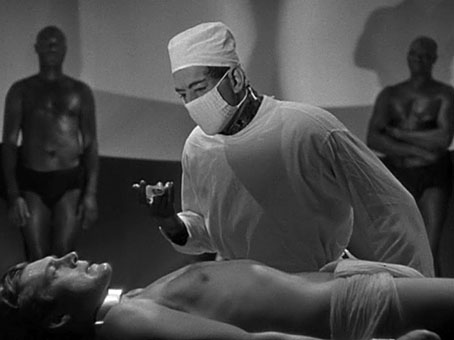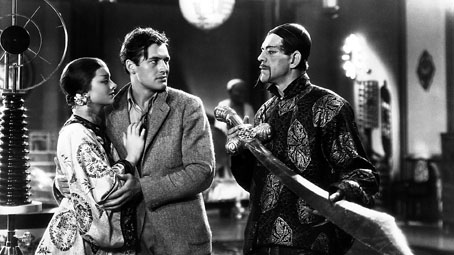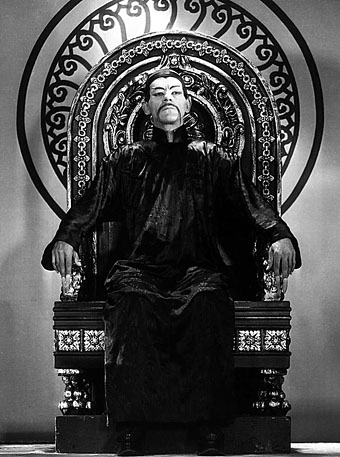Myrna Loy, Charles Starrett and Boris Karloff.
Los Alamos ranch school where they later made the atom bomb and couldn’t wait to drop it on the yellow peril. The boys are sittin’ on logs and rocks eating some sort of food there’s a stream at the end of a slope. The counsellor was a southerner with a politician’s look about him. He told us stories by the camp fire culled from the racist garbage of the insidious Sax Rohmer. “East is evil, west is good.”
William Burroughs
More pulp, and yes, it’s still racist garbage but Charles Brabin’s 1932 film which stars Boris Karloff as Sax Rohmer’s Oriental super-villain has its pleasures if you look past the severely dated attitudes. Together with The Black Cat (1934), where Boris plays a Satan-worshipping Modernist architect (!), this is one of the best non-Frankenstein Karloff films of the 1930s, as I was reminded this weekend when re-watching it along with several Sherlock Holmes episodes.
Christopher Lee is elegantly diabolical in the later Fu Manchu films but their cheap budgets force him to skulk around in dismal underground lairs. Karloff’s Doctor has a lavish Art Deco pad whose huge rooms are furnished with a noisy Van de Graaff generator and other scientific apparatus, plus a series of torture rooms where his guests may endure death by encroaching spikes (the “Slim Silver Fingers”), being lowered into an alligator pit, or driven mad by the incessant tolling of a giant bell. I happened to notice that the Doctor’s throne is quite possibly the same one (with a fresh coat of paint) as was used a decade earlier by a notoriously unclad Betty Blythe in The Queen of Sheba (1921), a lavish silent epic which is now unfortunately lost.
Betty Blythe as the Queen of Sheba.
The flaunting of Ms. Blythe’s breasts were one of the many occurrences which led to Hollywood’s adoption of the Hays Code in the 1930s, although the Code’s full effects weren’t felt until later in the decade. The notable scene in The Mask of Fu Manchu where hunk Charles Starrett appears strapped to a table dressed in nothing but a skimpy loin cloth (having previously been thrashed by Fu’s lustful daughter) would have been toned down considerably had the film been made a few years later. All the more reason to watch it today, such scenes only add to the fun.

The Doctor prepares to inject his captive with a serum which will turn the man into a compliant slave.
• The Mask of Fu Manchu | A page about the original serial, the subsequent novel and its illustrators.
Previously on { feuilleton }
• Wladyslaw Benda




Dreams are seldom logical or politically correct, and yet they are the inspiration many artists use. So while pulp often doesn’t seem to have any real message, it is often utterly divine to watch or read. Some of it ‘does’ have a point to it, regardless of what fossil-brained oscar viewers seem to think, but I’ve never really cared much for messages at all. I know multiple Asians, granted, all of them my age and living in Iowa, so not exactly good representatives of some larger community, who’ve seen all those Fu Manchu pictures, hell, one of them even owns them all. FM is great, though I like Fantomas more. Some of the pulps from Japan are excellent.
I agree absolutely about the dream-like nature of these tales, and this film especially. As we know, it was that quality which attracted the Surrealists to the Fantômas serials and Brabin’s film has much of the same atmosphere with its kidnappers disguised as Egyptian mummies and its elaborate tortures. The Black Cat has a very similar tone, so does White Zombie and the later Val Lewton films.
These are also 2 of my favorite pictures. The “Black Cat” also has the wonderful Art Deco mansion, “a masterpiece of construction but upon the masterpiece of destruction, a masterpiece of murder.” Karloff and Lugosi must have had fun making the movie and chewing the scenery. Karloff’s lisp was never put to better service: “one of the common phobias, an all conzzuming fear of cattz.”
The yellow peril of the “Fu Man Chu” film is the best part. It is a time capsule that informed American aptitudes during the Second World War and during the Korean War. I suppose the Doctor is a modern Genghis Khan, preparing to finish the work of his role model
How did the gorgeous and funny Myrna Loy get cast as his daughter? She looked uncomfortable and must have felt mis-cast in the surrealistic panorama. I understand that they need a big star like Karloff to open the picture but it’s unfortunate that they could not give the secondary roles to real Asian actors. Why not Ann May Wong as the daughter? Fortunately Myrna Loy redeemed herself in “the Thin Man” series.
Hi Richard. I’ve long thought the same about the marvellous Anna May Wong! She was only 26 at the time so it wasn’t as if she was too old. Myrna Loy looks a lot less Oriental than Boris does.
About ten years ago I was writing an unfinished and rather pointless (since it had no outlet) extended essay about the various manifestations of Aleister Crowley in cinema. Ulmer’s Black Cat was included since Karloff’s character is reputed to have been modelled on Crowley, as well as being based on the real German architect, Hans Poelzig. Ulmer and Poelzig worked on one of the Golem films in Germany, hence Boris being named “Hjalmar Poelzig”.
Hello John,
Stills from both The Mask of Fu Manchu and The Black Cat, found in Denis Gifford’s A Pictorial History of Horror Movies, quite freaked me out as a child. When I watched the latter on TV a few years later, mixed in with the classic Universal fare, I was very taken with the unshown brutality of it all. Watching it now, it’s a bleak classic of just over sixty minutes, despite the usual romance/comedy insertions. Lugosi and Karloff are two obsessed, doomed men, destined to perrish in the Art-Deco nightmare/headstone that represents all they exist for. Poelzig stealing Werdegast’s wife and THEN his daughter is just downright pure evil!
My favourite line: “You hear that Vitus? The phone is dead. Even the phone is dead.”
Cheers,
Martin.
Gee…!We know Sax Rohmer was a radical righ wing fighter, we know racism was far and wide those days, and yet… There will never be another Boris Karloff, wether asthe monsterof Frankenstein, Fu Manchu, or whatever.
Best!
Martin: I love that Dennis Gifford book (no surprise there), so many wonderful b&w images, many of them a lot more fascinating and provocative than the films themselves. For some reason the still for Mask of Fu Manchu shows Nayland Smith at the mercy of the Slim Silver Fingers whereas in the film he ends up strapped to the see-saw in the alligator room.
All this discussion of The Black Cat makes me want to see it again.